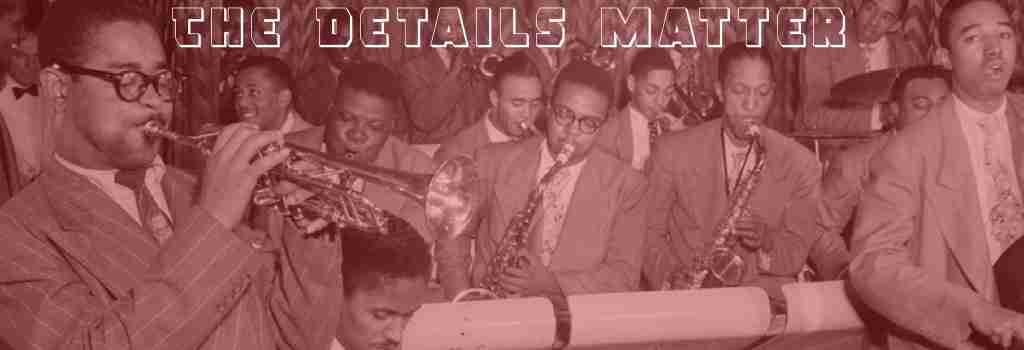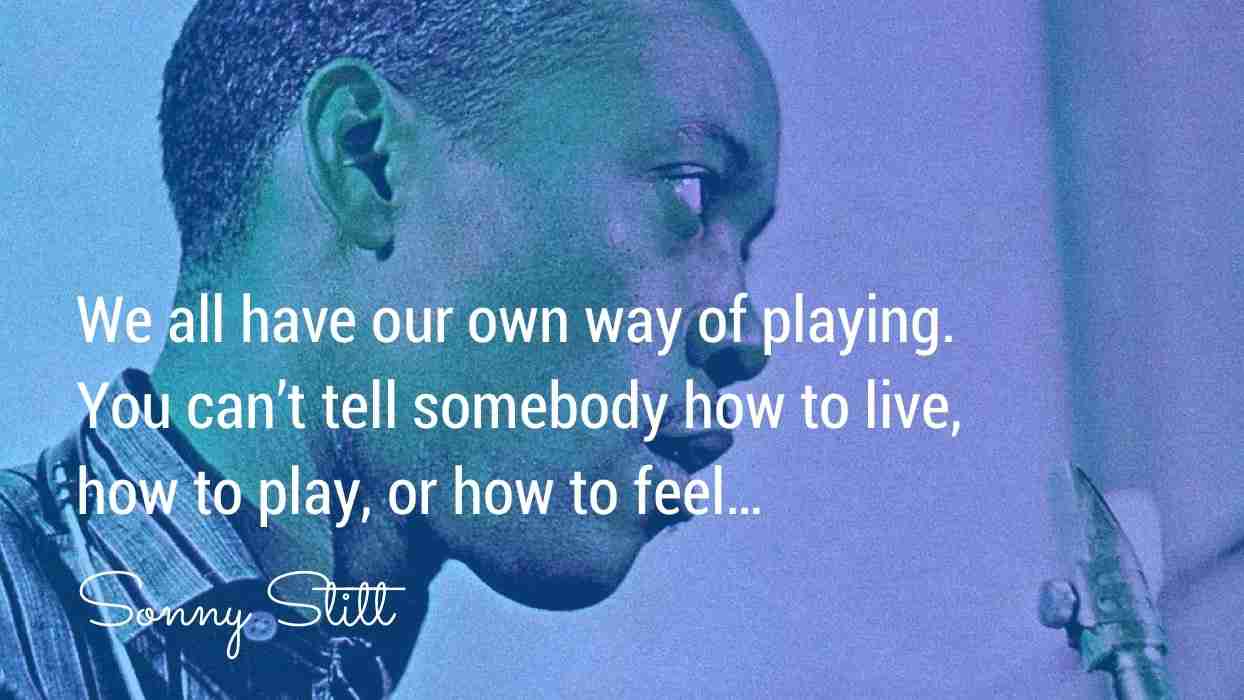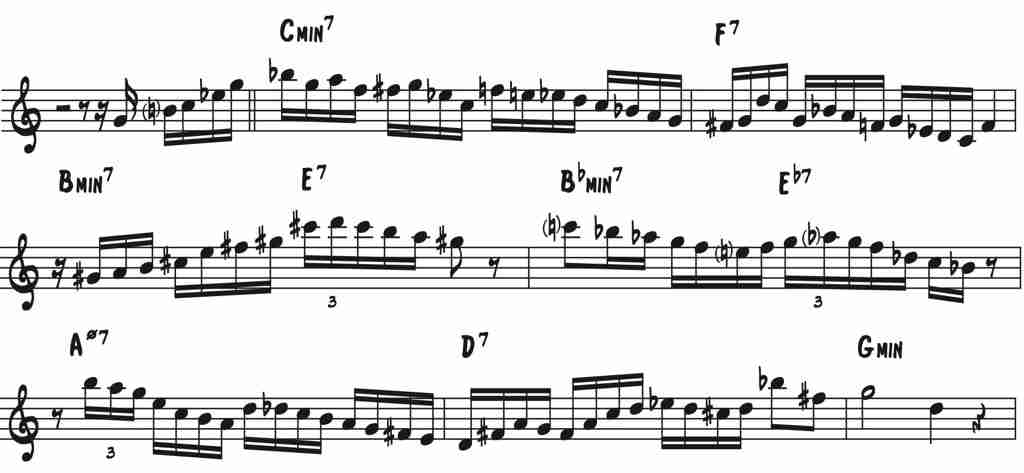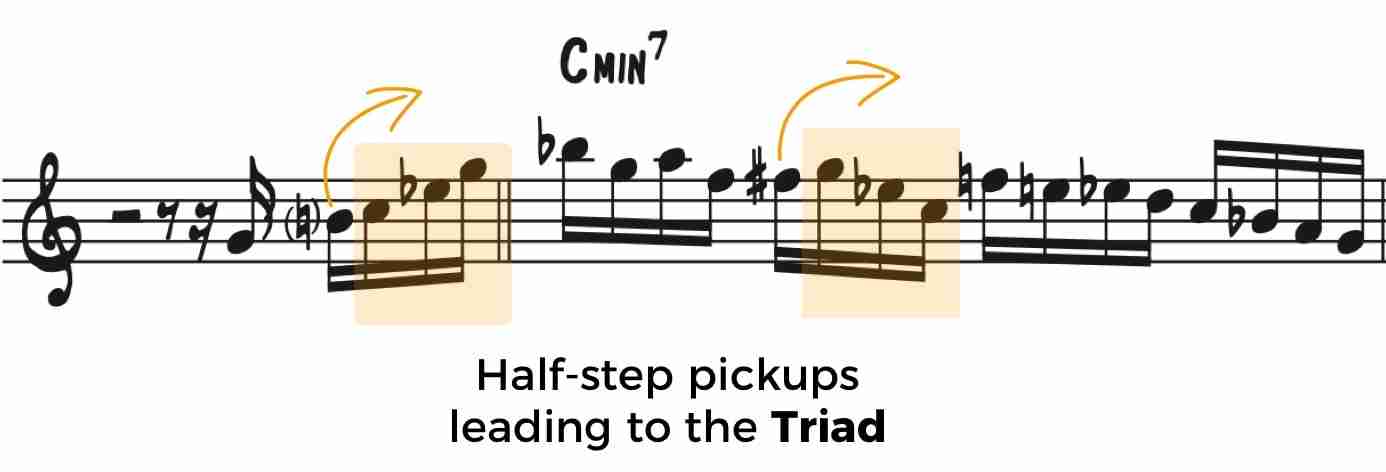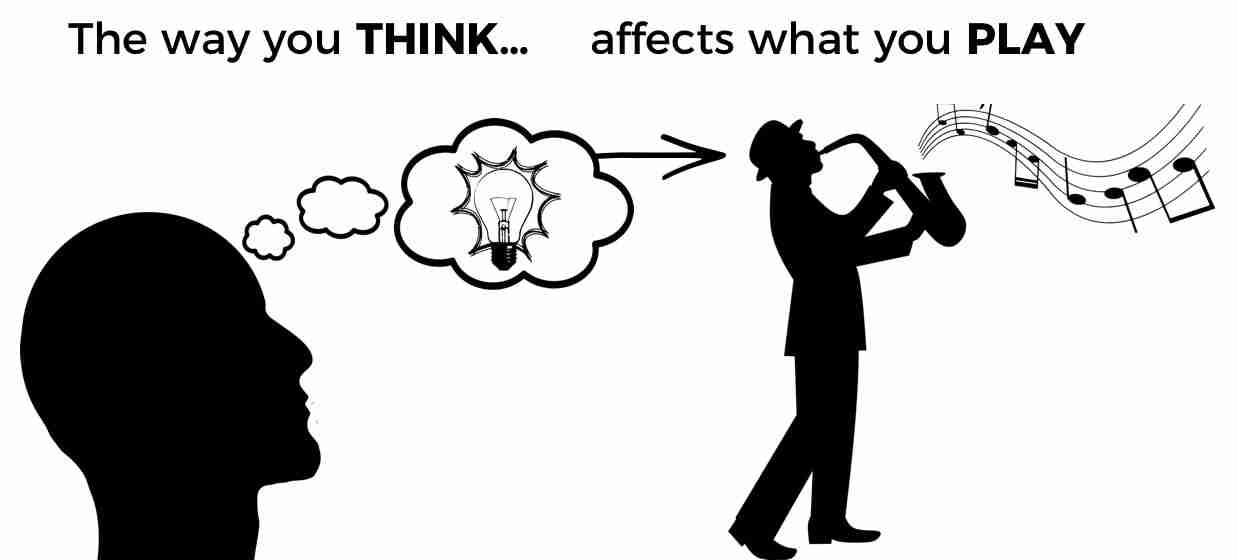Bebop language is at the very heart of jazz. From the classic beboppers to the crazy out players, every great jazz improviser has spent time absorbing, imitating, and developing timeless bebop language. There’s just something about the feel, phrasing, and voice leading of bebop language that’s crucial for every jazz musician to understand…
And to gain this understanding, jazz education has produced many books, theories, and massive collections of bebop licks that attempt to distill the greatness of this particular set of jazz language down to its essence.
In fact years ago, I can recall buying all sorts of books on how to play bebop, thinking “Okay, now all I have to do is learn these bebop licks and scale patterns and I’ll TOTALLY have a grasp on the bebop language!!”
But even with focused practice, my bebop language never really evolved…Nothing sounded natural and my bebop lines didn’t jump out at the listener the way the pro’s lines did. And I’m sure you can relate…
The thing is, the bebop language is difficult for every developing improviser to grasp and it can’t be summed up in a few licks, scales, or theories…
So when it comes to the bebop language, what are we all missing?? Just like everything in jazz, it’s the little details that get lost in the shuffle that make all the difference.
And these little details are usually passed right over, never given a second thought that they actually might be crucial…
But by digging into the music and hearing these little details for yourself, you’ll start to get what makes bebop language special, because it’s a lot more than just the notes – it’s an accent placed in just the right spot, a cliche bebop line used in a creative way, or a slight shift in how you think about the chord changes…
The most effective bebop techniques are not always straightforward the way we’re taught or the way we want it to be, with everything fitting into nice easy-to-understand boxes…
No single grand theory, scale, technique, or lick will ever encapsulate what makes the bebop language tick. It’s simply not possible. But, by studying a perfect line or two by one of your favorite bebop legends, you’ll uncover the subtle details that make bebop language so incredible.
Today we’ll call on one of the greatest bebop masters of all time – Sonny Stitt.
With his own take and unique approach to the bebop language, we’ll check out one of my all time favorite recordings, Boss Tenors, featuring both Sonny Stitt and the monster tenor player Gene Ammons.
Have a listen to the opening track Autumn Leaves and you’ll quickly understand why I love this album so much…
But did you notice that the chord changes don’t quite sound the same as you’re likely familiar with…that there’s something a little different in there??
Before we get into Sonny Stitt’s bebop language, let’s first take a look at what they’re doing to the classic jazz standard Autumn Leaves…
Autumn Leaves Chord Changes on Boss Tenors
Autumn Leaves is one of the first real tunes that beginner jazz students often learn, but that doesn’t mean that it’s a beginner tune!
In jazz, no tune is exclusively a beginner or advanced tune because every single tune, even Autumn Leaves, has its own challenges and story to unravel…
And what I mean by this so-called story is the general theme of the tune – the string of logic behind it that makes it work and the ideas the composer is playing with to craft the progression.
In Autumn Leaves, this story is all about how you travel between the major key and relative minor key, seamlessly moving between the two, yet ultimately being overcome by the minor sound.
But this standard progression is not what we hear Sonny Stitt and Gene Ammons play during their solos. Have a listen to the beginning of Gene Ammon’s solo and see if you can tell what’s going on in bars 3 and 4 of the A section during their solos…
If you’ve trained your ear like a jazz musician, then you can probably hear that they’re inserting a couple ii V progressions, and that they’re moving these ii Vs down in half steps…
And remember that in general, chord changes make logical sense because if they didn’t, they wouldn’t sound structured.
Doesn’t it seem logical to travel between C- F7 and A-7b5 D7 by inserting two ii Vs so the whole progression simply becomes ii Vs moving down in half steps?
Use your ear in combination with your sense of musical logic and you’ll be able to quickly determine what’s happening in the changes.
Okay, so now that we have the alternate chord changes that they’re using to Autumn Leaves, let’s take a peek into the brilliant bebop mind of Sonny Stitt…
Sonny Stitt The Bebop King
Sonny Stitt, during his lifetime and even today, lives in Bird’s shadow…
Charlie Parker was such an innovator and his playing was so powerful that players like Sonny Stitt are often forgotten about or not even put into the same class as someone like Bird…
But not everything in life is a comparison.
Sonny Stitt’s playing is great and his sound, phrasing, vocabulary, and overall playing concept is remarkably different from Parker’s when you get down to studying both of them.
Focusing some study on someone like Sonny Stitt can be hugely beneficial for any eager jazz student wanting to learn the bebop language because Stitt’s playing is so clear, as you heard on the incredible album Boss Tenors.
And when a musician’s playing is super clear, it’s usually easier to transcribe, conceptualize, and quickly adopt their tactics into your own playing, as you’ll see with Stitt’s incredible melodic lines on Autumn Leaves.
I can remember hearing this line many years ago – my jaw dropped right open.
Crazy right??
You might need to listen to that again a little slower to grasp just how amazing Sonny Stitt really is…here it is a bit slower…
How does someone play with such precision? Such inventiveness? And sound completely effortless doing it?
That’s Stitt.
It’s like he’s not even trying and the craziest bebop lines just spew out of him.
And like many Sonny Stitt lines, there’s enough to study here for a year, but for now, we’re going to put this Stitt line under the microscope and give you 5 bebop tactics that you’ve got to start using today.
Bebop Tactic #1 – Use Half-step pickups on downbeats
Now say it one more time with me…I will always put chord-tones on downbeats…I will always put chord-tones on downbeats…I will always put chord-tones on downbeats…
I’m obviously exaggerating, but when you’re learning how to play jazz, sometimes it can feel like that – we become so used to targeting and placing chord-tones on downbeats, we forget that it’s not a rule set in stone that we have to obey all the time.
The problem is, our mind and fingers get so used to doing things this way, so it rarely occurs to us to place a non-chord-tone on the downbeat…But, using the right non-chord-tones at the right time can open up a whole new avenue of creative possibility.
Sonny Stitt does just this by frequently adding half-step pickups on the downbeats throughout his lines.
Half-step pickups offer you an easy way to place non-chord tones on downbeats without sacrificing the harmonic logic present in the tune. In other words, you’ll be able to play non-chord-tones on downbeats but still accurately communicate the chords in your jazz lines.
In the first part of the line, notice how he approaches the minor triad with a half-step below the root and then a half-step below the fifth.
Using pick ups with a triad like this is an excellent and easy to use technique that will get you putting non-chord-tones on downbeats in a flash. This idea just scratches the surface on how powerful triads and approach notes can be – The Melodic Power Course covers both of these and more in great detail.
Now in the second part of the line, Stitt dips down from the 5th of the chord to a half-step below, landing on the down beat, and then right back up again.
This little dip down a half-step below the 5th adds a lot of dimension to this part of the line and is a huge part of what makes it sound the way it does.
But you aren’t limited to using pickups from below a chord-tone…you can just as easily use a half-step above or even use both as Stitt does here…
It’s time to revisit the idea that chord-tones have to be on downbeats all the time. Of course there’s a reason you learn to do this – by learning to put chord-tones on downbeats, you train yourself to easily and clearly express the chord sound through your melodic lines…
But when you’re ready to get beyond that, learn to retain the chord sounds in your line while occasionally adding in some half-step pickups on the downbeat.
When you introduce this tactic into your playing and become comfortable using it, you’ll open up a whole new side of your playing.
Tactic #2 – Change Up Your Accents
When you listen to Sonny Stitt solo, does it sound almost as if the notes are jumping off the recording into your ears?? It’s as if he’s playing in four dimensions!!
This quality comes from the shape, phrasing, and articulation of his lines, but it especially comes from where he places his accents.
Typically, we’re taught standard “jazz phrasing” which places the accents on the upbeats…so going over the top, Stitt’s line would have the accents more or less like this…
But this is certainly not how the line sounds at all…
He actually changes up where he places the accents in his lines, frequently shifting between upbeats and downbeats. Listen to this part of the line and you’ll hear his well-placed accent choices…
This is something to start thinking about, that you not only have a choice of where to place the accents in your line, but that the accents can and should reflect the shape of the very line you’re playing.
Aim to get beyond basic jazz articulation and accent lines in new creative ways. This is what gives the line interest and direction – It’s the thing that makes the line pop out at the listener and grab their attention.
Add this often overlooked tool to your repertoire and you’ll have that much more expressive capability at your fingertips.
Tactic #3 – Integrate cliche bebop language
When you’ve been playing and studying jazz for a while, you’ll start to hear and see many of the same bebop licks over and over.
And this is for good reason – these licks are a part of the jazz language, usually because they’re a fragment of a famous jazz standard, or they’re naturally a strong melodic idea that’s been inadvertently passed down for generations, knowingly or not.
But these bebop cliches can sound a bit pre-planned and unnatural if simply inserted into the chord changes…they need a bit more finesse to make them sound genuine.
This finesse comes from integrating cliche bebop licks into your lines by combining them with other material.
Two bebop ideas that you’ll find in this Sonny Stitt line and that you’ll literally find in everyone’s playing are:
- A descending minor fragment that goes 5321 and back up to 4
- A piece of and/or the whole descending bebop dominant scale
These may not look like much on paper, but out of the countless solos I’ve checked out, I run into these little pieces of language, in some form, in nearly every single one.
There are a million more common little bebop licks and ideas, and even several more in this line, but for today, let’s look at how Stitt integrates both the bebop dominant scale and this 53214 minor fragment into his line…have a look…
Notice how he sandwiches the bebop cliches between other material?
And even within this small section we transcribed today, Stitt uses both of these ideas a second time…
But because he integrates these essential pieces of bebop language so seamlessly, you probably didn’t even notice…
When you add pick ups before a bebop lick and immediately after connect it to other material, keeping your line flowing forward, you end up disguising your use of these cliches and you breathe new life into them.
Think about it like this…jazz is a language…
And in a language, everyone uses much of the same vocabulary, however, what makes one person’s communication unique from another, besides the words they use, is how they string vocabulary together and how they present it using their tone and inflection.
And that’s what we’re talking about here – taking the bebop licks you’ll find in everyone’s playing as you transcribe and then learning how to integrate them into your playing in a way that makes them sound natural, spontaneous, and necessary.
By adding this finesse to the bebop licks you study, you’ll even be able to use the same language multiple times in a single line, just like Stitt, and no one will even notice!
Bebop Tactic #4 – The Think of a different chord Trick
This trick plays a major role in how to improvise jazz and when you study the solos of the greats, it will become more and more clear to you that every great jazz improviser constantly switches up how they think when they play over a particular chord or progression…
For instance, when you’re playing over A minor, are you always thinking A minor in your mind?? If so, then it’s time to try something new because the way you think about the chord you’re playing over dictates how you approach your melodic line.
And it can be as simple as thinking D7 or a ii V over A minor instead of thinking about the singular chord…
These subtle shifts in how you think dramatically change what you improvise because they trigger different information to rise to the top of your consciousness.
Sonny Stitt rarely thinks of just the chord that’s in the chord changes. Here’s just one way he might have been thinking over this…
And the goal is not to determine without a doubt how Sonny Stitt was thinking, you’re not trying to prove anything. You’re trying to figure out a way YOU can think that would produce a similar result.
Here’s another part of Stitt’s line where thinking of other chords might inspire the resulting line…
When you’re transcribing and analyzing jazz lines from your favorite players, get beyond what scale they’re using and ask yourself, “How was this musician thinking when they played this??”
Get inside their head and try to hear and play from their perspective. When you learn to think like your heroes, you transcend licks and lines, and it becomes easy to make use of everything you’re learning from them.
Bebop Tactic #5 – Apply various levels of tension
Every once in a blue moon, you might hear a jazz teacher talk about tension and release…but almost never does anybody break down what this actually means.
The problem is we get so caught up in what scale to use, what substitution to apply, or what new crazy concept to learn instead of just thinking about the most essential element of music that applies to rhythm, melody, and harmony!
Tension and Release.
When you start seeing and hearing every aspect of music through the filter of how much tension it brings to the table, your entire concept changes
No matter what you improvise, it’s going to have a certain level of tension in it…
But, it’s up to you to figure out how to apply the level of tension you want for any specific moment.
Sonny Stitt is a master of tension.
He’s trained himself to hear where he wants to place a little tension, some tension, or a lot of tension…
And he clearly communicates these levels of tension in his lines by thinking about chords that reflect these levels, while he varies his rhythmic figures, accents, direction, and volume to support how much tension he wants to use.
Have a look at what he’s doing in this part of the line and you’ll hear exactly how Sonny Stitt applies various levels of tension.
Now all these levels of tension go back to Bebop Tactic #4, how you think about the chord changes. Stitt thinks of different chords that reflect these levels of tension which naturally help him architect the line the way he wants to.
Most people would stick to the chord changes here, simply thinking of a minor ii V , but Stitt doesn’t do that.
Instead of a minor ii V he plays a regular major ii V, leading to an unaltered V7 sound, and it’s not until right before the resolution point where he places the altered dominant sound in his line.
Start becoming aware of how you’re using tension and resolution in your lines, and thinking in these terms. With every chord, scale, chord-tone, or concept you use, begin to understand how it allows you to better apply tension and release.
And notice the patterns of tension that great players follow, for example, in Stitt’s line it’s very clear that the tension gradually builds and peaks right before the resolution point. This is a very common tension and resolution pattern to use.
Thinking in terms of various amounts of tension and release will help you a lot to better hear, categorize, and wield any jazz improvisation concept you encounter.
Mastering the Bebop Language
The bebop language is so deep, and it’s a whole lot more than some common bebop licks, a couple bebop scales, and few theories…
You need all this and more.
Get your licks, scales, and theory, but move beyond all of them and observe the minute details that are critical to making bebop language come alive. Things like the 5 bebop tactics from Sonny Stitt we talked about today…
- Pick ups on downbeats
- Accents that emphasize the shape of the line
- Creative use of common bebop language
- Interesting ways to think about the changes
- Various levels of tension and release
And use these tactics from Sonny Stitt as a starting point to understand what to look for and how to look for it when you’re transcribing your next solo or studying your next bebop line.
With the right mindset and some tenacity, you too can extract all the secrets from the great bebop legends.

